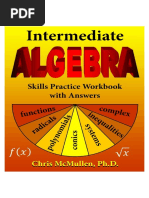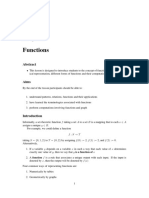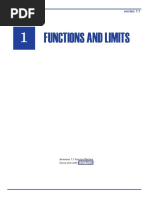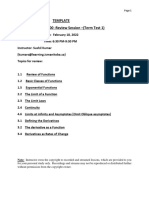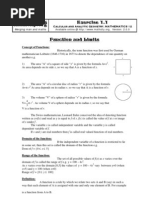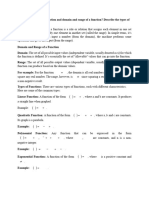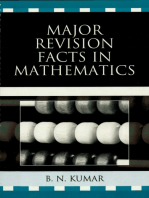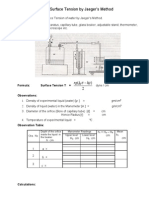(Calc 1) Functions
Uploaded by
mmostafa01090444794(Calc 1) Functions
Uploaded by
mmostafa01090444794Mathematics (1)
Calculus
For Preparatory Year and SSP
Fall 2024
Lecture (1)
Functions
By: Dr.\ Ahmed M. Makhlouf
Faculty of Engineering
Alexandria University
Mathematics (1)
▪ Functions.
Calculus ▪ Differential calculus.
▪ Integral calculus.
▪ Matrices.
▪ Algebraic operations on matrices.
Algebra ▪ Systems of linear equations.
▪ Gauss elimination.
▪ Conic sections.
Analytical Geometry ▪ Applications of conic sections.
Mathematics (1) ---- Dr.\ Ahmed M. Makhlouf
References
[1] Robert T. Smith & Roland B. Minton, Calculus, 4th Edition (2011).
[2] Ron Larson & Bruce Edwards, Calculus: Early Transcendental Functions,
7th Edition (2015).
[3] James Stewart, Calculus: Early Transcendentals, 8th Edition (2015).
Mathematics (1) ---- Dr.\ Ahmed M. Makhlouf
Functions
A function 𝑓 is a rule that assigns exactly one element 𝑦 in a set 𝐵 to each
element 𝑥 in a set 𝐴.
In this case, we write 𝑦 = 𝑓 𝑥 𝐴 𝐵
𝑦=𝑓 𝑥
𝑥 is referred as the independent variable.
𝑦 is referred as the dependent variable.
𝑥
𝑦
➢ Also, function can be considered as an operator that operates on its input(s)
and results in one output.
𝑥 𝑓 𝑦
Independent Dependent
variable variable
Mathematics (1) ---- Dr.\ Ahmed M. Makhlouf
Functions
Note that: If 𝑦 = 𝑥 2 , then: 𝑓 ∎ = ∎2
𝑥 𝑓 𝑥2 𝑥2 𝑓 𝑥4
2
𝑓 𝒙 = 𝒙2 𝑓 𝒙𝟐 = 𝒙𝟐 = 𝑥4
Note that: If 𝑓 𝑥 = 𝑥 3 and 𝑔 𝑦 = 𝑦 3 , then:
𝑓 ∎ = ∎3 𝑔 ∎ = ∎3
𝑓 𝑥 ≠𝑔 𝑦
𝑓 𝑥 =𝑔 𝑥
𝑓 𝑦 =𝑔 𝑦
Mathematics (1) ---- Dr.\ Ahmed M. Makhlouf
Examples
Ex 1: If 𝑓 5𝑥 = 𝑥 2 , find 𝑓 𝑥 .
Solution: Another Solution:
𝑓 5∎ = ∎2 ∵ 𝑓 5𝑥 = 𝑥 2
𝑦 2
𝒙 𝒙 2 Let 𝑦 = 5𝑥 ∴𝑓 𝑦 =
𝑓 5 = 5
𝟓 𝟓
Replace 𝑦 by 𝑥 2
𝒙 2 𝑥
∴𝑓 𝑥 = ∴𝑓 𝑥 =
𝟓 5
𝑥
Ex 2: If 𝑓 = 𝑥 3 , find 𝑓 𝑥 .
3
Solution:
𝒙
𝑓 = 𝒙3
3
Replace 𝑥 by 3𝑥
3𝑥 3 3
∴𝑓 = 3𝑥 ∴ 𝑓 𝑥 = 3𝑥
3
Mathematics (1) ---- Dr.\ Ahmed M. Makhlouf
Functions
A function 𝑓 is a rule that assigns exactly one element 𝑦 in a set 𝐵 to each
element 𝑥 in a set 𝐴.
The set 𝐴 is called the domain of 𝑓.
The set of all values 𝑓 𝑥 in 𝐵 is called the range of 𝑓.
𝐴 𝐵
𝑦=𝑓 𝑥
𝑥 𝑦
Then:
The domain of 𝑓 is the set of all allowed values of 𝑥.
The range of 𝑓 is the set of all values of 𝑓 𝑥 for all 𝑥 ∈ the domain.
Mathematics (1) ---- Dr.\ Ahmed M. Makhlouf
Functions
A function 𝑓 is a rule that assigns exactly one element 𝑦 in a set 𝐵 to each
element 𝑥 in a set 𝐴.
Note that: It is not allowed for an element 𝑥 in the domain of a function to have
more than one value for 𝑓 𝑥 .
𝐴 𝐵 𝐴 𝐵
𝑥 𝑦 𝑥 𝑦
Not a function (It is a relation) A function
Ex: 𝑦 2 = 𝑥 Ex: 𝑦 = 𝑥
Mathematics (1) ---- Dr.\ Ahmed M. Makhlouf
Vertical Line Test
➢ Graphically, it can be determined whether a curve is the graph of a function by
using the vertical line test.
➢ Vertical line test: If any vertical line intersects the graph in more than one point,
the curve is not the graph of a function.
𝑦 𝑦
𝑥 𝑥
Not a function A function
Mathematics (1) ---- Dr.\ Ahmed M. Makhlouf
Vertical Line Test
➢ Graphically, it can be determined whether a curve is the graph of a function by
using the vertical line test.
➢ Vertical line test: If any vertical line intersects the graph in more than one point,
the curve is not the graph of a function.
𝑦 𝑦
𝑥 𝑥
A function Not a function
Mathematics (1) ---- Dr.\ Ahmed M. Makhlouf
Algebraic Functions
➢ Power function.
➢ Polynomial.
➢ Rational function.
➢ Radical function.
(1) Power Function
The power function is 𝑦 = 𝑓 𝑥 , where:
𝑓 𝑥 = 𝑥𝑛 , 𝑛 ∈ ℝ
ℝ is the set of all real numbers.
Mathematics (1) ---- Dr.\ Ahmed M. Makhlouf
Special Cases of Power Function 𝑦 = 𝑥𝑛 , 𝑛 ∈ ℝ
𝑛=0⟹𝑦=1 𝑛=1⟹𝑦=𝑥
𝑦 𝑦
𝑥 𝑥
Domain = ℝ Domain = ℝ
Range = 1 Range = ℝ
Mathematics (1) ---- Dr.\ Ahmed M. Makhlouf
Special Cases of Power Function 𝑦 = 𝑥𝑛 , 𝑛 ∈ ℝ
𝑛 = 2 ⟹ 𝑦 = 𝑥2 𝑛 = 3 ⟹ 𝑦 = 𝑥3
𝑦 𝑦
𝑥 𝑥
Domain = ℝ
Domain = ℝ
Range = ℝ
Range = 0, ∞ = ℝ+ ⋃ 0
Mathematics (1) ---- Dr.\ Ahmed M. Makhlouf
Special Cases of Power Function 𝑦 = 𝑥𝑛 , 𝑛 ∈ ℝ
1
𝑛 = 4 ⟹ 𝑦 = 𝑥4 𝑛= ⟹𝑦= 𝑥
2
𝑦 𝑦
𝑥 𝑥
Domain = ℝ Domain = 0, ∞ = ℝ+ ⋃ 0
Range = 0, ∞ = ℝ+ ⋃ 0 Range = 0, ∞ = ℝ+ ⋃ 0
Mathematics (1) ---- Dr.\ Ahmed M. Makhlouf
Special Cases of Power Function 𝑦 = 𝑥𝑛 , 𝑛 ∈ ℝ
1 1
𝑛 = −1 ⟹ 𝑦 = 𝑛 = −2 ⟹ 𝑦 =
𝑥 𝑥2
𝑦 𝑦
𝑥 𝑥
Domain = ℝ − 0 Domain = ℝ − 0
Range = ℝ − 0 Range = ℝ+
Mathematics (1) ---- Dr.\ Ahmed M. Makhlouf
(2) Polynomials
A polynomial is any function that can be written in the form:
𝑓 𝑥 = 𝑎𝑛 𝑥 𝑛 + 𝑎𝑛−1 𝑥 𝑛−1 + ⋯ + 𝑎2 𝑥 2 + 𝑎1 𝑥 + 𝑎0
where 𝑎𝑛 , 𝑎𝑛−1 , ⋯, 𝑎2 , 𝑎1 , 𝑎0 are the coefficients of the polynomial and 𝑎𝑛 ≠ 0.
➢ 𝑛 is an integer such that 𝑛 ≥ 0.
➢ 𝑛 is the degree of the polynomial.
𝑓 𝑥 = 𝑎0 Polynomial of degree 0 (Constant function)
𝑓 𝑥 = 𝑎1 𝑥 + 𝑎0 Polynomial of degree 1 (Linear polynomial)
𝑓 𝑥 = 𝑎2 𝑥 2 + 𝑎1 𝑥 + 𝑎0 Polynomial of degree 2 (Quadratic polynomial)
𝑓 𝑥 = 𝑎3 𝑥 3 + 𝑎2 𝑥 2 + 𝑎1 𝑥 + 𝑎0 Polynomial of degree 3 (Cubic polynomial)
For any polynomial, the domain = ℝ
Also, Polynomials can be defined as a linear combination of power functions with 𝑛
non-negative integers.
Mathematics (1) ---- Dr.\ Ahmed M. Makhlouf
Examples
Ex 3: For each of the following functions, determine whether it is a
polynomial or not and if so, determine its degree.
(1) 𝑓 𝑥 = 𝑥 3 − 𝑥 + 1 (2) 𝑓 𝑥 = 𝑥 5 + 𝑥 + 2
1
(3) 𝑓 𝑥 = 𝑥 − 2𝑥 + 3 (4) 𝑓 𝑥 = − 𝑥 2 − 1
𝑥
Solution:
(1) 𝑓 𝑥 = 𝑥 3 − 𝑥 + 1 Polynomial of degree 3
(2) 𝑓 𝑥 = 𝑥 5 + 𝑥 + 2 Polynomial of degree 5
(3) 𝑓 𝑥 = 𝑥 − 2𝑥 + 3 Not a polynomial
1
(4) 𝑓 𝑥 = 𝑥 − 𝑥 2 − 1 Not a polynomial
Mathematics (1) ---- Dr.\ Ahmed M. Makhlouf
(3) Rational Function
A rational function is any function that can be written in the form:
𝑝 𝑥
𝑓 𝑥 =
𝑞 𝑥
where 𝑝 𝑥 and 𝑞 𝑥 are polynomials.
The domain = ℝ − zeros of 𝑞 𝑥
➢ Recall: Zeros of 𝑞 𝑥 are the values of 𝑥 that make 𝑞 𝑥 = 0.
𝑥+3
Ex: For the function 𝑓 𝑥 = 𝑥2−1
Zeros of the denominator 𝑥 2 − 1 are 𝑥 = 1 and 𝑥 = −1
∴ The domain of 𝑓 𝑥 = ℝ − −1, 1
𝑝 𝑥
Note: Zeros of 𝑞 𝑥 are called the poles of the function 𝑓 𝑥 = 𝑞 𝑥
Mathematics (1) ---- Dr.\ Ahmed M. Makhlouf
(4) Radical Function
𝑛
Radical function is 𝑦 = 𝑓 𝑥 , where: 𝑓 𝑥 = 𝑥
➢ If 𝑛 = 2 , then the function is 𝑦 = 𝑥
The domain of 𝑦 = 𝑥 is given by 𝑥 ≥ 0.
3
➢ If 𝑛 = 3 , then the function is 𝑦 = 𝑥
3
The domain of 𝑦 = 𝑥 is ℝ.
Restrictions in finding the domain:
1 1
∎ ⟹ ∎≥0 ⟹ ∎≠0 ⟹ ∎>0
∎ ∎
Mathematics (1) ---- Dr.\ Ahmed M. Makhlouf
Examples
Ex 4: Find the domain of the following functions:
(1) 𝑓 𝑥 = 2𝑥 − 7 (2) 𝑔 𝑥 = 𝑥 3 + 2𝑥 − 5
Solution:
(1) The domain of 𝑓 𝑥 =ℝ
(2) The domain of 𝑔 𝑥 =ℝ
The domain of any polynomial = ℝ
Mathematics (1) ---- Dr.\ Ahmed M. Makhlouf
Examples
Ex 5: Find the domain of the following function:
3𝑥 − 8
𝑓 𝑥 = 2
𝑥 − 9𝑥 + 20
Solution:
Zeros of the denominator at: 𝑥 2 − 9𝑥 + 20 = 0
𝑥−4 𝑥−5 =0
∴ 𝑥 = 4 and 𝑥 = 5
∴ The domain = ℝ − 4, 5
Mathematics (1) ---- Dr.\ Ahmed M. Makhlouf
Examples
Ex 6: Find the domain of the following function:
𝑓 𝑥 = 𝑥−4
Solution:
The domain: 𝑥−4≥0
∎ ⟹ ∎≥0
∴𝑥≥4
∴ The domain = 4, ∞
Mathematics (1) ---- Dr.\ Ahmed M. Makhlouf
Examples
Ex 7: Find the domain of the following function:
𝑓 𝑥 = 𝑥 2 + 3𝑥 − 28
Solution:
The domain: 𝑥 2 + 3𝑥 − 28 ≥ 0
∴ 𝑥−4 𝑥+7 ≥0
+ + + + + + − − − − + + + + + +
−7 4
∴ The domain = −∞, −7 ⋃ 4, ∞
= ℝ − −7, 4
Mathematics (1) ---- Dr.\ Ahmed M. Makhlouf
Examples
Ex 8: Find the domain of the following function:
𝑥−4
𝑓 𝑥 = 2
𝑥 − 25
Solution:
𝑥−4≥0 and 𝑥 2 − 25 ≠ 0
∴𝑥≥4 ∴ 𝑥 ≠ ±5
−5 4 5
∴ The domain = 4, ∞ − 5
= 4, 5 ∪ 5, ∞
Mathematics (1) ---- Dr.\ Ahmed M. Makhlouf
Examples
Ex 9: Find the domain of the following function:
𝑥−2
𝑓 𝑥 =
Solution: 𝑥+3 𝑥+1
𝑥−2 𝑥+3 𝑥+1 ≠0
≥0 and
𝑥+3 𝑥+1
∴ 𝑥 ≠ −3 , −1
− − − −−− + + − −− + + + + + +
−3 −1 2
∴ The domain = −3, −1 ⋃ 2, ∞
Mathematics (1) ---- Dr.\ Ahmed M. Makhlouf
Examples
Ex 10: Find the domain of the following function:
𝑥−2
𝑓 𝑥 =
Solution: 𝑥+3 𝑥+1
𝑥−2≥0 𝑥+3 𝑥+1 >0
and
∴𝑥≥2
+ + ++ + + − − + + + + + + + ++ ++
−3 −1 2
∴ The domain = 2, ∞
Mathematics (1) ---- Dr.\ Ahmed M. Makhlouf
Important Remark
The domain is always found before any simplifications.
𝑥−2 𝑥−2
Ex 9: 𝑓 𝑥 = Ex 10: 𝑓 𝑥 =
𝑥+3 𝑥+1 𝑥+3 𝑥+1
Domain = −3, −1 ⋃ 2, ∞ Domain = 2, ∞
𝑦 𝑦
−3 −1 2 𝑥 −3 −1 2 𝑥
Mathematics (1) ---- Dr.\ Ahmed M. Makhlouf
Important Remark
The domain is always found before any simplifications.
Illustration:
𝑥 2 −25
For the function 𝑓 𝑥 = 𝑥−5
The domain = ℝ − 5 Correct
Incorrect Solution:
𝑥−5 𝑥+5
𝑓 𝑥 = =𝑥+5
𝑥−5
The domain = ℝ Incorrect
Mathematics (1) ---- Dr.\ Ahmed M. Makhlouf
Good Luck
Dr.\ Ahmed M. Makhlouf
You might also like
- Chris McMullen - Intermediate Algebra Skills Practice Workbook With Answers - Functions, Radicals, Polynomials, Conics, Systems, Inequalities, and (2021, Zishka Publishing) - Libgen - Li100% (3)Chris McMullen - Intermediate Algebra Skills Practice Workbook With Answers - Functions, Radicals, Polynomials, Conics, Systems, Inequalities, and (2021, Zishka Publishing) - Libgen - Li502 pages
- MATH165 CO1 Lesson 1.8 Intro To FunctionsNo ratings yetMATH165 CO1 Lesson 1.8 Intro To Functions22 pages
- Functions and Limits: Animation 1.1: Function Machine Source and Credit: Elearn - PunjabNo ratings yetFunctions and Limits: Animation 1.1: Function Machine Source and Credit: Elearn - Punjab23 pages
- University of Zimbabwe: Mte 101 Engineering Mathematics 1No ratings yetUniversity of Zimbabwe: Mte 101 Engineering Mathematics 121 pages
- 1 Differential Calculus_241218_184823 (1)No ratings yet1 Differential Calculus_241218_184823 (1)81 pages
- MTH4100 Calculus I: Lecture Notes For Week 2 Thomas' Calculus, Sections 1.3 To 1.5No ratings yetMTH4100 Calculus I: Lecture Notes For Week 2 Thomas' Calculus, Sections 1.3 To 1.513 pages
- Math 2 S2 Ess_05a890fa6c5907c056556a3ea276a671No ratings yetMath 2 S2 Ess_05a890fa6c5907c056556a3ea276a67190 pages
- objective-mathematics-12th-by-muhammad-shahbazNo ratings yetobjective-mathematics-12th-by-muhammad-shahbaz150 pages
- Notes 1 Functions and Their Graphs (Calculus 1)No ratings yetNotes 1 Functions and Their Graphs (Calculus 1)14 pages
- XXXXXXXXXXXXXXX Functions: 1.1 MappingsNo ratings yetXXXXXXXXXXXXXXX Functions: 1.1 Mappings10 pages
- Lecture Notes On Function Mapping and Limits by Dr. AjijolaNo ratings yetLecture Notes On Function Mapping and Limits by Dr. Ajijola11 pages
- Complete Download Modern Optics Simplified Robert D. Guenther PDF All Chapters100% (1)Complete Download Modern Optics Simplified Robert D. Guenther PDF All Chapters47 pages
- (Supplements To The Study of Time 1) Fraser, Fraser Julius Thomas - Time and Time Again - Reports From A Boundary of The Universe-Brill (2007)No ratings yet(Supplements To The Study of Time 1) Fraser, Fraser Julius Thomas - Time and Time Again - Reports From A Boundary of The Universe-Brill (2007)448 pages
- Numerical Modelling and A Design of A Thermoelectric DehumidifierNo ratings yetNumerical Modelling and A Design of A Thermoelectric Dehumidifier16 pages
- Gas Solubility in Dilute Solutions: A Novel Molecular Thermodynamic PerspectiveNo ratings yetGas Solubility in Dilute Solutions: A Novel Molecular Thermodynamic Perspective17 pages
- [FREE PDF SAMPLE] Mechanics of Materials Brief Edition James M. Gere ebook full chapters100% (2)[FREE PDF SAMPLE] Mechanics of Materials Brief Edition James M. Gere ebook full chapters86 pages
- AQA Chemistry Bonding Structure and The Properties of Matter KnowIT GCSE1No ratings yetAQA Chemistry Bonding Structure and The Properties of Matter KnowIT GCSE176 pages
- Oil & Gas Industry Interview Questions Answers100% (1)Oil & Gas Industry Interview Questions Answers13 pages
- Premature Failures in Plate Bonded Strengthened RC Beams With An Emphasis On Premature Shear A Review PDFNo ratings yetPremature Failures in Plate Bonded Strengthened RC Beams With An Emphasis On Premature Shear A Review PDF13 pages
- Infrastructure As A Service (Iaas) : A Comparative Performance Analysis of Open-Source Cloud PlatformsNo ratings yetInfrastructure As A Service (Iaas) : A Comparative Performance Analysis of Open-Source Cloud Platforms6 pages
- A 1020 Template Study Guide 10 Star PropertiesNo ratings yetA 1020 Template Study Guide 10 Star Properties73 pages
- Chris McMullen - Intermediate Algebra Skills Practice Workbook With Answers - Functions, Radicals, Polynomials, Conics, Systems, Inequalities, and (2021, Zishka Publishing) - Libgen - LiChris McMullen - Intermediate Algebra Skills Practice Workbook With Answers - Functions, Radicals, Polynomials, Conics, Systems, Inequalities, and (2021, Zishka Publishing) - Libgen - Li
- Functions and Limits: Animation 1.1: Function Machine Source and Credit: Elearn - PunjabFunctions and Limits: Animation 1.1: Function Machine Source and Credit: Elearn - Punjab
- University of Zimbabwe: Mte 101 Engineering Mathematics 1University of Zimbabwe: Mte 101 Engineering Mathematics 1
- MTH4100 Calculus I: Lecture Notes For Week 2 Thomas' Calculus, Sections 1.3 To 1.5MTH4100 Calculus I: Lecture Notes For Week 2 Thomas' Calculus, Sections 1.3 To 1.5
- Lecture Notes On Function Mapping and Limits by Dr. AjijolaLecture Notes On Function Mapping and Limits by Dr. Ajijola
- A-level Maths Revision: Cheeky Revision ShortcutsFrom EverandA-level Maths Revision: Cheeky Revision Shortcuts
- Complete Download Modern Optics Simplified Robert D. Guenther PDF All ChaptersComplete Download Modern Optics Simplified Robert D. Guenther PDF All Chapters
- (Supplements To The Study of Time 1) Fraser, Fraser Julius Thomas - Time and Time Again - Reports From A Boundary of The Universe-Brill (2007)(Supplements To The Study of Time 1) Fraser, Fraser Julius Thomas - Time and Time Again - Reports From A Boundary of The Universe-Brill (2007)
- Numerical Modelling and A Design of A Thermoelectric DehumidifierNumerical Modelling and A Design of A Thermoelectric Dehumidifier
- Gas Solubility in Dilute Solutions: A Novel Molecular Thermodynamic PerspectiveGas Solubility in Dilute Solutions: A Novel Molecular Thermodynamic Perspective
- [FREE PDF SAMPLE] Mechanics of Materials Brief Edition James M. Gere ebook full chapters[FREE PDF SAMPLE] Mechanics of Materials Brief Edition James M. Gere ebook full chapters
- AQA Chemistry Bonding Structure and The Properties of Matter KnowIT GCSE1AQA Chemistry Bonding Structure and The Properties of Matter KnowIT GCSE1
- Premature Failures in Plate Bonded Strengthened RC Beams With An Emphasis On Premature Shear A Review PDFPremature Failures in Plate Bonded Strengthened RC Beams With An Emphasis On Premature Shear A Review PDF
- Infrastructure As A Service (Iaas) : A Comparative Performance Analysis of Open-Source Cloud PlatformsInfrastructure As A Service (Iaas) : A Comparative Performance Analysis of Open-Source Cloud Platforms
